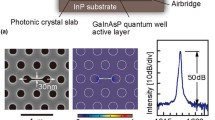Abstract
A label-free method for detecting the attachment of human cancer cells to a biosensor surface for rapid screening for biological activity is described, in which attachment of a cell results in highly localized increase of the resonant reflected wavelength of a photonic crystal narrowband reflectance filter incorporated into a standard 96-well microplate. An imaging detection instrument is used to determine the spatial distribution of attached cells by mapping the shift in reflected resonant wavelength as a function of position. The method enables monitoring of cancer cell attachment, cell proliferation, and cell detachment that is induced by exposure of the cells to drug compounds. We demonstrate the efficacy of this method as an early screening technique for the rapid quantification of the rate of cancer cell proliferation on the sensor surface, and subsequently as a means for quantifying cell detachment resulting from apoptosis that is induced by exposure of the cells to cytotoxic chemicals.




Similar content being viewed by others
References
Dive C et al (1992) Analysis and discrimination of necrosis and apoptosis (programmed cell-death) by multiparameter flow-cytometry. Biochimica Et Biophysica Acta 1133:275–285
Schwartzman RA, Cidlowski JA (1993) Apoptosis—the biochemistry and molecular-biology of programmed cell-death. Endocr Rev 14:133–151
Huang P, Plunkett WA (1992) Quantitative assay for fragmented Dna in apoptotic cells. Anal Biochem 207:163–167
Bortner CD, Oldenburg NBE, Cidlowski JA (1995) The role of Dna fragmentation in apoptosis. Trends Cell Biol 5:21–26
Verhoven B, Schlegel RA, Williamson P (1995) Mechanisms of phosphatidylserine exposure, a phagocyte recognition signal, on apoptotic T-lymphocytes. J Exp Med 182:1597–1601
Petit PX, Susin SA, Zamzami N, Mignotte B, Kroemer G (1996) Mitochondria and programmed cell death: Back to the future. FEBS Lett 396:7–13
Zou H, Henzel WJ, Liu XS, Lutschg A, Wang XD (1997) Apaf-1, a human protein homologous to C-elegans CED-4, participates in cytochrome c-dependent activation of caspase-3. Cell 90:405–413
Ellis HM, Horvitz HR (1986) Genetic-control of programmed cell-death in the nematode C-elegans. Cell 44:817–829
Takagi S, McFadden ML, Humphreys RE, Woda BA, Sairenji T (1993) Detection of 5-bromo-2-deoxyuridine (brdurd) incorporation with monoclonal anti-brdurd antibody after deoxyribonuclease treatment. Cytometry 14:640–648
Zourob M et al (2005) Bacteria detection using disposable optical leaky waveguide sensors. Biosens Bioelectron 21:293–302
Cooper MA (2003) Label-free screening of bio-molecular interactions. Nature 377:834–842
Cunningham BT, Li P, Lin B, Pepper J (2002) Colorimetric resonant reflection as a direct biochemical assay technique. Sensors and Actuators B 81:316–328
Haes AJ, Duyne RPV (2002) A nanoscale optical biosensor: sensitivity and selectivity of an approach based on the localized surface plasmon resonance spectroscopy of triangular silver nanoparticles. J Am Chem Soc 124:10596–10604
Joannopoulos JD, Meade RD, Winn JN (1995) Photonic crystals. Princeton University Press, Princeton, NJ
Munk BA (2000) Frequency selective surfaces. John Wiley & Sons, New York
Lin B, Li P, Cunningham BT (2005) A label-free biosensor-based cell attachment assay for characterization of cell surface molecules. Sensors and Actuators B (Accepted April 2005)
Cunningham BT et al (2004) Label-free assays on the BIND system. J Biomol Screen 9:481–490
Coleman RE et al (2006) A randomised phase II study of two different schedules of pegylated liposomal doxorubicin in metastatic breast cancer (EORTC-10993). Eur J Cancer 42:882–887
Joyner DE, Bastar JD, Randall RL (2006) Doxorubicin induces cell senescence preferentially over apoptosis in the FU-SY-1 synovial sarcoma cell line. J Orthop Res 24:1163–1169
Syng-ai C, Kumari AL, Khar A (2004) Effect of curcumin on normal and tumor cells: Role of glutathione and bcl-2. Mol Can Ther 3:1101–1108
Suwei Wang EAK, Kotamraju Srigiridhar, Joseph Joy, Kalivendi Shasi, Kalyanaraman B (2004) Doxorubicin induces apoptosis in normal and tumor cells via distincly different mechanisms intermediacy of H202-AND p53-dependent pathways. J Biol Chem 279:25535–25543
Sun JR, Cheng KC, Pan TY, Si XM (2002) A new acyclic sesquiterpene oligoglycoside from pericarps of Sapindus mukurossi. Chin Chem Lett 13:555–556
Yoshiharu Fujii SSP, Mohammad Masud Parvez, Yoshio Ohmae, Osamu Iida (2003) Screening of 239 medicinal plant species for allelopathic activity using the sandwich method. Weed Biol Manag 3:233–241
Dhar JD, BV, Setty BS, Kamboj VP (1989) Morphological changes in human spermatozoa as examined under scanning electron microscope after in vitro exposure to saponins isolated from Sapindus mukorossi. Contraception 39:563–568
Yata N, SN, Yamajo R, Murakami T, Higashi Y, Kimata H, Nakayama K, Kuzuki T, Tanaka O (1985) Enhanced rectal absorption of beta-lactam antibiotics in rat by monodesmosides isolated from pericarps of Sapindus mukurossi (Enmei-hi). J Pharmacobiodyn 8:1041–1047
Chi KN et al (2000) Effects of Bcl-2 modulation with G3139 antisense oligonucleotide on human breast cancer cells are independent of inherent Bcl-2 protein expression. Breast Can Res Treat 63:199–212
Acknowledgments
This material is based upon work supported by the National Science Foundation under Grant no. 0427657. Any opinions, findings, and conclusions or recommendations expressed in this material are those of the author(s) and do not necessarily reflect the views of the National Science Foundation. The authors would like to thank Professor R. Chowdhury from University of Dhaka, Bangladesh for providing the plant extracts. The authors gratefully acknowledge SRU Biosystems for the providing the photonic crystal biosensor microplates. The authors also extend their gratitude to the support staff of the Micro and Nanotechnology Laboratory at the University of Illinois at Urbana-Champaign.
Author information
Authors and Affiliations
Corresponding author
Rights and permissions
About this article
Cite this article
Chan, L.L., Gosangari, S.L., Watkin, K.L. et al. A label-free photonic crystal biosensor imaging method for detection of cancer cell cytotoxicity and proliferation. Apoptosis 12, 1061–1068 (2007). https://doi.org/10.1007/s10495-006-0031-y
Published:
Issue Date:
DOI: https://doi.org/10.1007/s10495-006-0031-y




